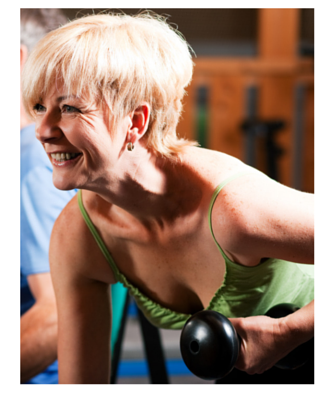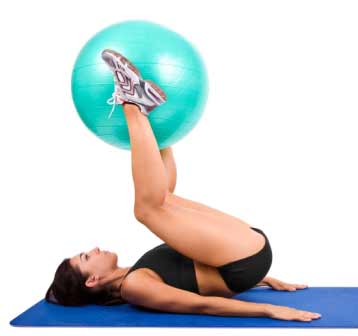
I’d like to introduce you to Rose.
Rose is in her 80’s and she started whole body strengthening exercise classes 4 years ago. Rose says …
“Strengthening has given me confidence in my balance and the awareness of my capabilities in everyday situations. I feel happy and energized after our classes.
Doing strength exercises has given me more stability in my stride as I go about my busy day.”
Whole body strengthening can help women stay strong, positive and active regardless of age or stage of life.
Guide to Safe Whole Body Strengthening
I’ve had the pleasure of exercising with Rose from when she first started out.
Here’s how Rose got started and stays strong plus Physiotherapist tips to help you get started safely too.
1. Starting Out
Rose got the OK to exercise from her doctor and she was ready to start.
If you’ve never exercised before get your doctor’s approval to commence strength exercises.
If you’re over 65 years or 50-65 living with a chronic medical condition you need to develop an exercise plan with a health professional.
2. Choosing your Resistance Exercises
Choose resistance exercises and a format that you enjoy. 
Some women like to exercise at home using light hand weights and guided strength exercises (e.g. Physio whole body strength exercise DVD).
Others like Rose enjoy group exercise (and the coffee afterwards!).
If you’re going to stick with your exercise routine it needs to be something you enjoy.
There are many different forms of whole body strengthening available for mature women including:
Choose exercises that involve your major muscle groups; a good strengthening routine usually involves around 10-12 exercises for the major muscle groups i.e. muscles of the legs, buttocks, back, core, chest, arms and shoulders.
3. Existing Injuries
If you have a health condition or an existing injury, you’ll benefit from expert guidance in choosing the most appropriate resistance exercises for your body.
Here are a few health issues confronting many women:
A. Arthritis – if you suffer from arthritis whole body strengthening can help support your joints and improve the ease of everyday activities. Water-based exercise is often an ideal form of exercise with arthritis as it reduces the load on your joints while allowing you to strengthen the muscles that support your joints.
[product_block product=”inside-out-strength”]
B. Pelvic Floor Problems – if you suffer from pelvic organ prolapse, incontinence, pelvic pain or if you’ve had previous pelvic surgery you’ll benefit from staying active with pelvic floor safe strengthening techniques and whole body strengthening exercises (see Inside Out DVD).
C. Shoulder Problems – shoulder problems need not prevent you from exercising. Rose had surgery on one shoulder years ago – when she started exercising she couldn’t comb the back of her hair with her that hand. She started upper body strengthening focusing on upper back strengthening and she avoids potentially aggravating exercises including overhead shoulder exercises. Now Rose can comb her hair with her right hand and her upper body strength is much improved.
D. ‘Bad’ Knees – if you have knee pain you’ll benefit from appropriate leg strengthening exercises and avoiding inappropriate leg exercises such as deep squats, lunges and/or high step ups that can overload the knee joints. If you’re unsure about exercising with existing knee problems see your local physiotherapist and ask for him/her to recommend appropriate knee (and whole body) exercises for you to include in your exercise program.
4. Good Posture 
Exercising with good upright posture is important for getting the most out of upright resistance exercises and avoiding injury.
Having good posture during exercise helps you activate deep abdominal muscles and your pelvic floor for support during your strength exercises.
Good upright posture involves:
- Raising the crown of your head
- Lengthening your spine and standing (or sitting) tall
- Raising your chest (sternum) forwards and slightly upwards.
Rose has always had great posture from her years of dancing in her youth. This good posture helps her maintain good form throughout her exercises.
5. Correct Technique
Using the correct technique during resistance exercises helps you get the most benefit from your exercises and minimize your risk of injury.
When starting out the most important thing for you to learn is the correct exercise technique. Once you’ve learnt this, you can usually progress to gradually increasing your resistance.
Incorrect exercise technique decreases the effectiveness of strength exercises and can increase the likelihood of physical injury.
One of the benefits of exercising with Rose on a weekly basis has been that we’ve been able to refine her technique over time. This is one reason why seeking expert instruction with your technique at the outset of your whole body strengthening program can help you towards success.
6. Start with Low Resistance or Light Weights
Start your whole body strengthening using light resistance. Light resistance means using less rather than more resistance or load for the first couple of weeks at least.
Using low resistance gives you time to learn to use good technique with your exercises and helps reduce your risk of injury.
Avoid progressing your resistance (or load) until you’re confident in your technique and feeling comfortable with your resistance exercises.
Rose started out using 1 kg (2.2 lb) dumbbells for all of her exercises. She can now use 12 kg or 26.4 lb (total) for her mini squat leg exercises with ease (shown above).
7. Avoid Heavy Resistance Exercises
Mature women are vulnerable to injury with heavy loading activities and high resistance exercises.
After menopause muscle strength naturally decreases as does tissue elasticity.
These changes increase a woman’s risk of:
- Joint injury with heavy resistance exercises
- Pelvic floor problems including pelvic organ prolapse and bladder control problems
The solution is to keep your resistance low, progress the load very gradually and focus more on increasing the number of repetitions or repeated exercises you do rather than increasing the load you lift.
What about Osteoporosis Exercises?
Research tells us that heavy resistance exercise is beneficial for bone health.
If you’re a mature woman with osteoporosis or if you’re at increased risk of decreased bone density resistance exercises need to be appropriate to your body, your current level of strength and your risk of bone fracture with exercises.
Osteoporosis exercises don’t need to incorporate heavy resistance – mild to moderate resistance exercises can load bones, improve bone health and help you avoid injury.
Your Physiotherapist can work with you to devise a strength training program to help you safely strengthen if you’re seeking safe exercises with osteoporosis.
8. Avoid Intense Core Abdominal Strength Exercises 
Intense core abdominal strength exercises (shown right) are usually inappropriate for mature women. Sit-ups or abdominal crunch exercises increase the load and downward pressure on the pelvic floor.
If your pelvic floor is weak or if you’ve had pelvic surgery (hysterectomy, prolapse or incontinence repair) intense abdominal exercises can overload your pelvic floor contributing to prolapse and/or incontinence problems.
Appropriate gentle core abdominal strength exercises that avoid intense abdominal bracing are best suited to mature women.
Rose has always been keen to do abdominal strengthening. We’ve always made sure that her abdominal core exercises are pelvic floor safe always avoiding abdominal crunches or sit-up exercises.
9. Listen to Your Body
Listen to what your body tells you i.e. your symptoms with exercises.
It’s completely normal to feel some muscle soreness a day or two after resistance exercises, in fact this is a normal part of the muscle strengthening process.
Undue discomfort and pain during or after exercise is a sign that some feature of your exercise isn’t suited to your body – it might be your technique, too much resistance or an existing injury/condition. In this case stop and either modify your exercise or choose an alternative exercise. Never persist with any exercise that causes you pain or discomfort.
10. Modify Exercises 
Don’t be afraid to modify your resistance exercises if they cause you physical discomfort.
Most resistance exercises are easily modified to suit individual differences. If you’re having difficulty with an exercise ask your instructor to provide you with an alternative exercise that strengthens the same muscle group. Personal trainers and group fitness leaders are usually happy to assist with modified or alternative exercises.
Rose still continues to modify some of the exercises she performs using her right shoulder as some positions feel uncomfortable for her. Rose’s long-term shoulder problem does not preclude her from exercises, rather it means she modifies or avoids exercises potentially compromising for her shoulder.
11. Progress Gradually
Progression is the key to ongoing strengthening; if you stay at the same level of resistance without challenging your muscles to work harder your muscle strength will plateau and stay the same. To increase your strength you need to increase your load or resistance.
While it may be tempting to increase your resistance quickly when you’re feeling good, it’s much safer to increase resistance gradually over time.
Most women can increase resistance in small increments approximately 6 weeks apart. Progressing your resistance gradually might involve as little as .5 kg (1.1 lb) increase or doing just a few extra repetitions of exercise at a higher resistance before returning to your regular load.
12. Breathe Out with Effort
Breathing out with your effort can help you reduce your blood pressure and the load on your pelvic floor during resistance exercise.
Try to breathe out when you lift, lower, push or pull the load.
13. Recover and Rest
Take the time your body needs to rest between sets (groups) of resistance exercises.
Resting allows your muscles (including your pelvic floor muscles) to recover so they can work effectively before your next strength effort.
14. Right Amount of Exercise
Start with the number of exercises you can comfortably do – even if it’s 1-2 exercises in a row. Gradually increase the number of exercises you do over time.
Ideally whole body strengthening exercises should involve:
- At least 2 strengthening sessions a week.
- 8-10 exercises for the main muscle groups
- At least 1 set (group) of 10-15 repeated exercises
15. Expert Instruction
Most mature women can safely participate in whole body strengthening despite age, stiff knees, sore shoulders, lower back pain, pelvic floor problems and more.
Accessing professional assistance and overcoming fear of injury are often the greatest hurdles to getting and staying active.
If you’re not sure about how to go about safe strengthening, get some professional assistance. This can be as simple as a visit to your Physiotherapist to get you started.
Where to Access Safe Whole Body Strengthening 
Check our pelvic floor safe exercise directory for a pelvic floor safe provider near you or speak with your doctor about exercise providers in your area.
More help can be accessed through:
- Exercise Physiologists
- Personal trainers who specialize in exercise for mature women
- Community centers conducting exercises for mature women
- Physiotherapists
Physiotherapists are trained to understand strengthening for existing injuries and unsafe exercises to avoid worsening your condition.
In Australia you don’t need a doctor’s referral to see a Physiotherapist. If you’re living with a medical condition your doctor may be able to recommend an Exercise Physiologist to prescribe an appropriate exercise program for you.
If you’re in Australia and living with chronic health problems that can benefit from exercise:
- Speak with your doctor about your eligibility for an EPC (Enhanced Primary Care program) that subsidizes the costs of allied health including Physiotherapy.
- If you have a Veteran’s Affairs card you may have subsidized access to Physiotherapy exercise classes.
- Many health funds subsidize health professional exercise classes.
So why not find out about whole body strengthening exercises in your area?
You never know, just like inspirational Rose – you might just gain a whole new lease on life!










